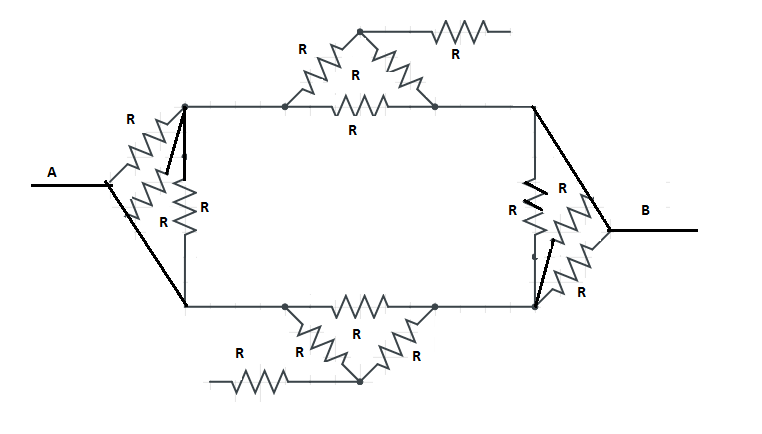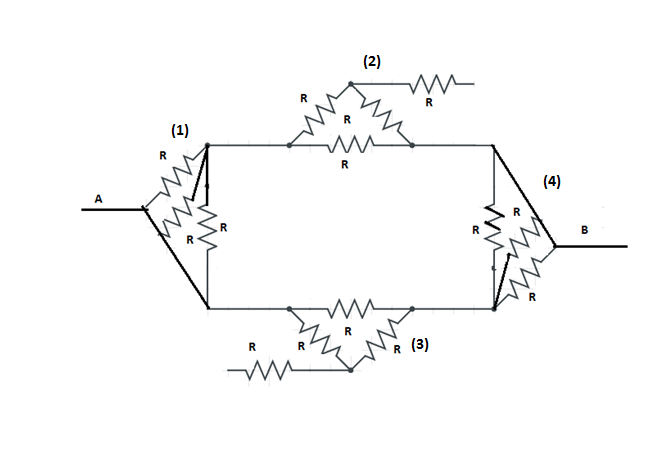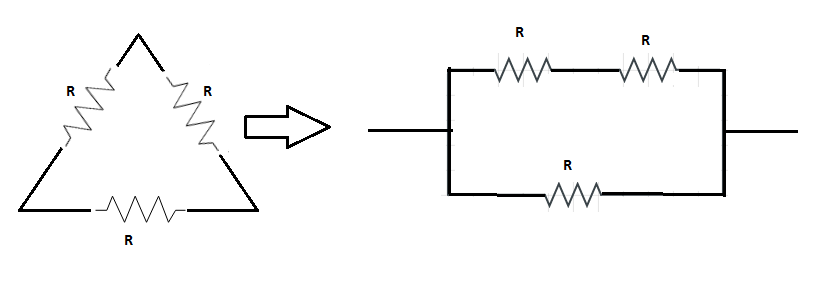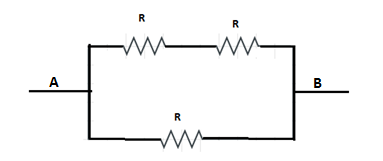
Find the equivalent resistance between A and B

$\begin{align}
& A.\text{ }R \\
& B.\text{ }\dfrac{3R}{4} \\
& C.\text{ }\dfrac{R}{2} \\
& D.\text{ }2R \\
\end{align}$

Answer
541.8k+ views
Hint: As we know that current only flows in a closed loop of circuit therefore first we will ignore resistance that are not closed loop then after we will simplify the given circuit even further by using the formula for the resistance either connected in parallel or in series which will gives us equivalent resistance of a circuit.
Formula used:
$\begin{align}
& {{R}_{e}}={{R}_{1}}+{{R}_{2}}+......{{R}_{n}} \\
& \dfrac{1}{{{R}_{e}}}=\dfrac{1}{{{R}_{1}}}+\dfrac{1}{{{R}_{2}}}+....\dfrac{1}{{{R}_{n}}} \\
\end{align}$
Complete answer:
As we know those current flows only when the circuit is in closed loop now as we can see that upper and the lower resistance is not in a closed loop therefore we can remove or ignore those two resistances as shown in the figure.

Now as to simplify the circuit we have divided it in 4 parts now for part 2 and 3,

In the triangle circuit two resistors are in the series with each other and both are in parallel with the third resistance,
Now the equivalent resistance is,
$\begin{align}
& \Rightarrow \dfrac{1}{{{R}_{e}}}=\dfrac{1}{R+R}+\dfrac{1}{R} \\
& \Rightarrow \dfrac{1}{{{R}_{e}}}=\dfrac{3R}{2{{R}^{2}}} \\
& \therefore {{R}_{e}}=\dfrac{2}{3}R \\
\end{align}$
Now for the part (1) and the part (4)

As we can see that all the three resistance are in the parallel therefore equivalent resistance is,
$\begin{align}
& \Rightarrow \dfrac{1}{{{R}_{e}}}=\dfrac{1}{R}+\dfrac{1}{R}+\dfrac{1}{R} \\
& \Rightarrow \dfrac{1}{{{R}_{e}}}=\dfrac{3}{R} \\
& \therefore {{R}_{e}}=\dfrac{R}{3} \\
\end{align}$
Now put all the 4 parts equivalent resistance in the main circuit to simplify the given circuit further.

For the part (5) and (6)
$\begin{align}
& {{R}_{e}}=\dfrac{R}{3}+\dfrac{2}{3}R \\
& {{R}_{e}}=\dfrac{3R}{3} \\
& {{R}_{e}}=R \\
\end{align}$
Putting the values of the part (5) and part (6) in a circuit,

Now both resistances are in parallel with each other.
$\begin{align}
& \Rightarrow \dfrac{1}{{{R}_{e}}}=\dfrac{1}{R}+\dfrac{1}{R} \\
& \Rightarrow \dfrac{1}{{{R}_{e}}}=\dfrac{2}{R} \\
& \therefore {{R}_{e}}=\dfrac{R}{2} \\
\end{align}$
Therefore correct option is (C) $\dfrac{R}{2}$ .
Note:
As an approach to solve this question first we remove two resistances that are not in a closed loop then we divide circuit in 4 parts and find their equivalent resistance to simplify the circuit and by putting values of 4 parts we again divided circuit in 2 parts and find equivalent resistance of them finally we got equivalent resistance between A and B.
Formula used:
$\begin{align}
& {{R}_{e}}={{R}_{1}}+{{R}_{2}}+......{{R}_{n}} \\
& \dfrac{1}{{{R}_{e}}}=\dfrac{1}{{{R}_{1}}}+\dfrac{1}{{{R}_{2}}}+....\dfrac{1}{{{R}_{n}}} \\
\end{align}$
Complete answer:
As we know those current flows only when the circuit is in closed loop now as we can see that upper and the lower resistance is not in a closed loop therefore we can remove or ignore those two resistances as shown in the figure.

Now as to simplify the circuit we have divided it in 4 parts now for part 2 and 3,

In the triangle circuit two resistors are in the series with each other and both are in parallel with the third resistance,
Now the equivalent resistance is,
$\begin{align}
& \Rightarrow \dfrac{1}{{{R}_{e}}}=\dfrac{1}{R+R}+\dfrac{1}{R} \\
& \Rightarrow \dfrac{1}{{{R}_{e}}}=\dfrac{3R}{2{{R}^{2}}} \\
& \therefore {{R}_{e}}=\dfrac{2}{3}R \\
\end{align}$
Now for the part (1) and the part (4)

As we can see that all the three resistance are in the parallel therefore equivalent resistance is,
$\begin{align}
& \Rightarrow \dfrac{1}{{{R}_{e}}}=\dfrac{1}{R}+\dfrac{1}{R}+\dfrac{1}{R} \\
& \Rightarrow \dfrac{1}{{{R}_{e}}}=\dfrac{3}{R} \\
& \therefore {{R}_{e}}=\dfrac{R}{3} \\
\end{align}$
Now put all the 4 parts equivalent resistance in the main circuit to simplify the given circuit further.

For the part (5) and (6)
$\begin{align}
& {{R}_{e}}=\dfrac{R}{3}+\dfrac{2}{3}R \\
& {{R}_{e}}=\dfrac{3R}{3} \\
& {{R}_{e}}=R \\
\end{align}$
Putting the values of the part (5) and part (6) in a circuit,

Now both resistances are in parallel with each other.
$\begin{align}
& \Rightarrow \dfrac{1}{{{R}_{e}}}=\dfrac{1}{R}+\dfrac{1}{R} \\
& \Rightarrow \dfrac{1}{{{R}_{e}}}=\dfrac{2}{R} \\
& \therefore {{R}_{e}}=\dfrac{R}{2} \\
\end{align}$
Therefore correct option is (C) $\dfrac{R}{2}$ .
Note:
As an approach to solve this question first we remove two resistances that are not in a closed loop then we divide circuit in 4 parts and find their equivalent resistance to simplify the circuit and by putting values of 4 parts we again divided circuit in 2 parts and find equivalent resistance of them finally we got equivalent resistance between A and B.
Recently Updated Pages
A man running at a speed 5 ms is viewed in the side class 12 physics CBSE

The number of solutions in x in 02pi for which sqrt class 12 maths CBSE

State and explain Hardy Weinbergs Principle class 12 biology CBSE

Write any two methods of preparation of phenol Give class 12 chemistry CBSE

Which of the following statements is wrong a Amnion class 12 biology CBSE

Differentiate between action potential and resting class 12 biology CBSE

Trending doubts
What are the major means of transport Explain each class 12 social science CBSE

Which are the Top 10 Largest Countries of the World?

Draw a labelled sketch of the human eye class 12 physics CBSE

Explain sex determination in humans with line diag class 12 biology CBSE

Explain sex determination in humans with the help of class 12 biology CBSE

Differentiate between homogeneous and heterogeneous class 12 chemistry CBSE




